Minds On
Four kinds of land-use impact

There are four kinds of impacts that are considered when land use is changed: social, economic, political, and environmental impact.
Press the following tabs to explore the kinds of impacts.
As you explore the range of land-use issues in the next sections, notice what impacts are being considered.
Brainstorm
Land-use
Brainstorm a list of reasons that people might argue over land.
Complete the following Brainstorming Land-Use activity in your notebook or using the following fillable and printable document. You can also use another method of your choice.
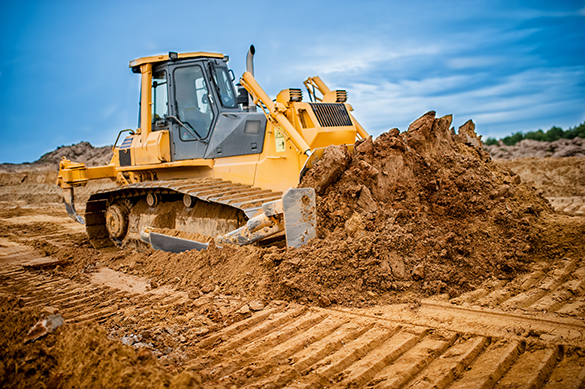

Press ‘Example’ to reveal some possible answers.
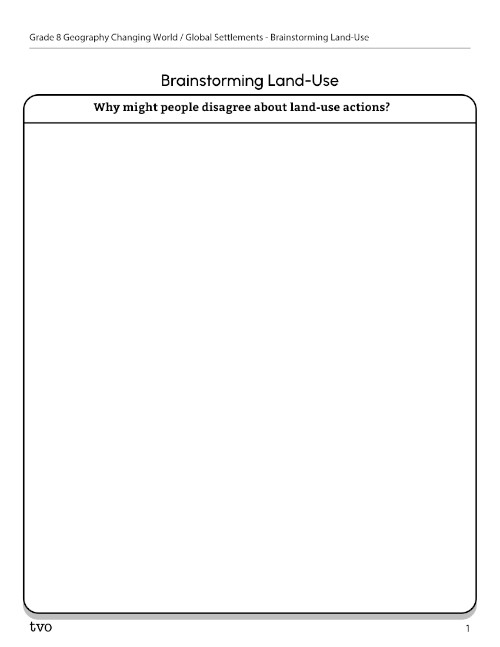
Press the Activity button to access the Brainstorming Land-Use activity.
Activity(Opens in a new tab)Action
Land-use issues
There are many nations and communities that exist across Turtle Island.
Turtle Island is the name many First Nations people and communities use to refer to lands known as North America today. In many First Nations creation stories, there are references to a human world that is flooded by water. The turtle, in various version stories, is an integral part to providing land and life to first humans.
Many Indigenous communities believe that humans, fish, and animals are all equal and that the land and the water have a spirit that needs to be protected. Land in this sense cannot be owned, and instead land is shared. Indigenous territories are constantly evolving in both Canadian legal context and on the basis of kinship ties and relationship between Indigenous communities.
Developing land for settlement is rarely without competition and conflict. Land can be used for agriculture, industry, housing, transportation, recreation, and green spaces. When land issues arise, there are usually several different perspectives involved.
Task 1: Case Study – Caledonia
In the next section of the learning activity, you will be investigating a long-standing land rights issue between the Six Nations Peoples within the Haudenosaunee Confederacy and the government of Canada. This conflict has arisen due to a new residential development being built on an unresolved Haudenosaunee Confederacy land claim.
Begin by reading the following article. Next, complete the following Caledonia Land-Use Perspectives graphic organizer. Finally, you will choose one of three question to answer using what you have learned.
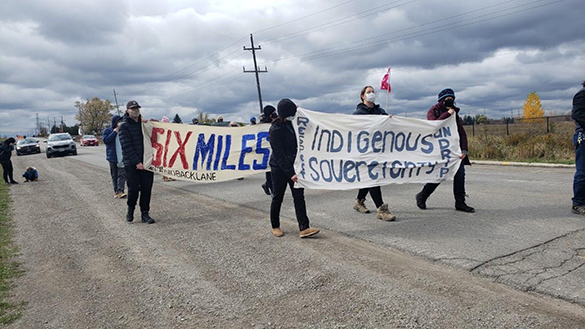
Press tvo today to access “Broken Promises, Unceded Land: The History Behind The Land Back Lane Protest.”
TVO dot org (Opens in a new tab)Using the information from the article you previously accessed, as well as information you gather through independent research, complete the following Caledonia Land-Use Perspectives graphic organizer. You can also use another method of your choice.
Press ‘Hint’ to explore two ideas to consider.
| Haudenosaunee Perspectives | |
| Housing Developer’s Perspectives | |
| Government Perspectives |
Press the ‘Activity’ button to access the Caledonia Land-Use Perspectives.
Check your answers using the following Caledonia Land-Use Perspectives – Answer Key. Some of the ideas in your graphic organizer may be different.
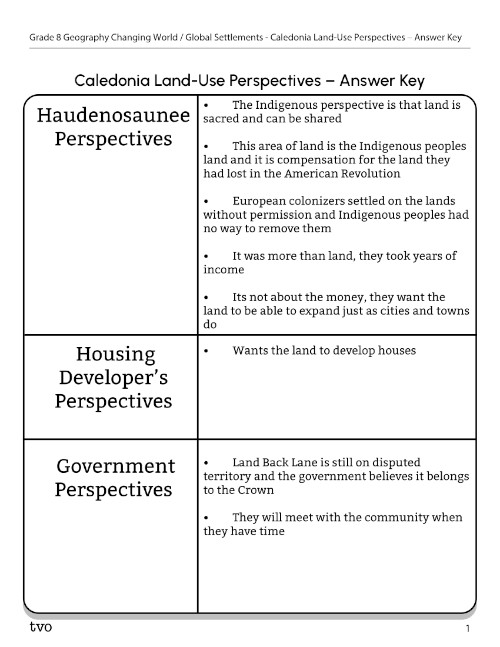
Press the Activity button to access the Caledonia Land-Use Perspectives – Answer Key.
Activity(Opens in a new tab)Further thinking
Now that you have a better understanding of the Caledonia Land-Use Conflict, respond to one of the following questions. Complete the following Questioning the Caledonia Land-Use Conflict Further activity in your notebook or using the following fillable and printable document. You can also use another method of your choice.
- How can all groups involved in this land-use conflict ensure their perspectives are heard?
Press ‘Hint’ to access a point to consider.
- Are some groups better at making their perspectives heard and known? Why do you think this happens?
Press ‘Hint’ to explore the following statements to think about.
- What criteria should the government follow when trying to help moderate land disputes that are similar to this one?
Press ‘Hint’ to consider the following questions.
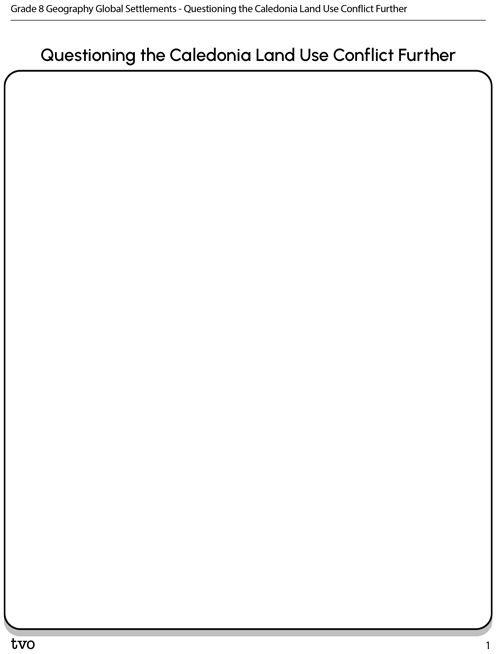
Press the Activity button to access the Questioning the Caledonia Land-Use Conflict Further.
Activity(Opens in a new tab)Task 2: Land reclamation

What is land reclamation?
Land reclamation is the process of creating new land by raising the elevation of oceans, seas, riverbeds, or lake beds. The land reclaimed is also known as reclamation ground or land fill.
Brainstorm
Brainstorm
Why might a country need to create new land from water?
Brainstorm a few possible reasons.
Record your ideas in a notebook or another method of your choice.
The simplest form of land reclamation involves filling the area with large amounts of heavy rock and/or cement, then filling with clay and soil until the desired height is reached. The first major land reclamation projects were carried out in the 1970s when a port in the Netherlands was extended. These projects were the start of the modern era of land reclamation, which rapidly spread around the world.
Hong Kong International Airport
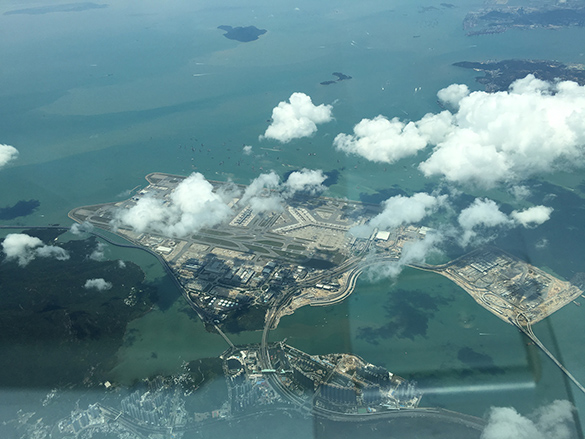
In the following section, we will explore the land reclamation at the Hong Kong International Airport. Representatives in Hong Kong have been exploring options to expand the International Airport, including adding another runway by 2030. They will be looking to reclaim 650 hectares of land that has been disturbed by other projects in the past. Forty percent of the selected area is contaminated with mud pits that have been used since 1992 to dispose of contaminated marine mud.
Contamination is when something is made impure by exposure to or addition of poisonous or polluting substances.
The Hong Kong International Airport will need to avoid the leakage of these mud pits. However, studies have shown there are no significant ecosystems in the purposed area and minimal dolphin activity. They have considered using two methods: land reclamation and drained reclamation. Explore the two possible methods in the following checklists.
Drained Reclamation Method
Deep Cement Mixing
Reflection
If you were the development director in Hong Kong, which methods would you recommend? Why?
Record your ideas in a notebook or a method of your choice.
Land reclamation – a case study
Choose one of the following Land Reclamation projects to investigate further. How does your chosen project compare to the Hong Kong International Airport? What are the positives and the negatives of land reclamation?
- United Arab Emirates in Palm Islands
- Fiery Cross Reef in China
- Jakarta in Indonesia
- Sanya Hongtangwan International Airport in China
Consider the positives and negatives of land reclamation in the Hong Kong project and your chosen land reclamation project you have explored in the previous section.
Record the positives and negatives of land reclamation in the following Positive and Negative Effects of Land Reclamation graphic organizer in your notebook or using the following fillable and printable document. You can also use another method of your choice.
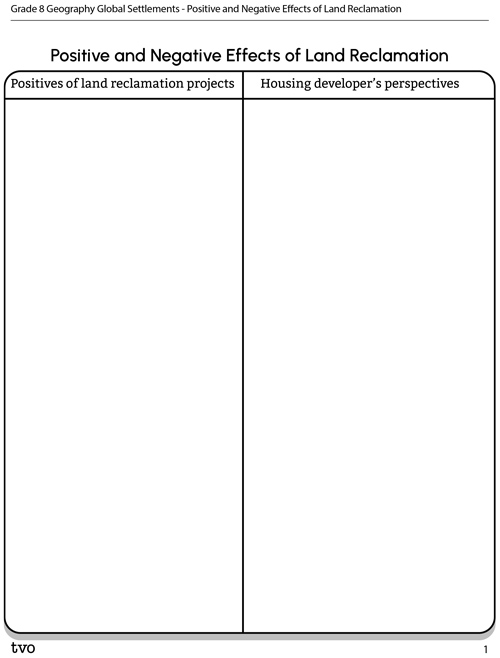
Press the Activity button to access the Positive and Negative Effects of Land Reclamation.
Activity(Opens in a new tab)Task 3: Impacts
Let's review!
There are four kinds of impacts that are considered when land use is changed: social, economic, political, and environmental impact. Before you begin, let’s review the differences between these impacts.
For each term, select the corresponding description.
Hurricane Hazel and the four kinds of impacts
Explore the following information about Hurricane Hazel. Then, assess the social, economic, political, and environmental impacts the hurricane had on Toronto, Ontario.
Press the following tabs to learn more about Hurricane Hazel.
While the storm struck Toronto in the form of heavy winds, the greatest destruction came in the form of flooding. Rivers overflowed, taking cars, ripping down entire homes, and knocking trains off their tracks. Volunteers tried to help, but they were up to their chins in water. Forty bridges were destroyed or structurally damaged.
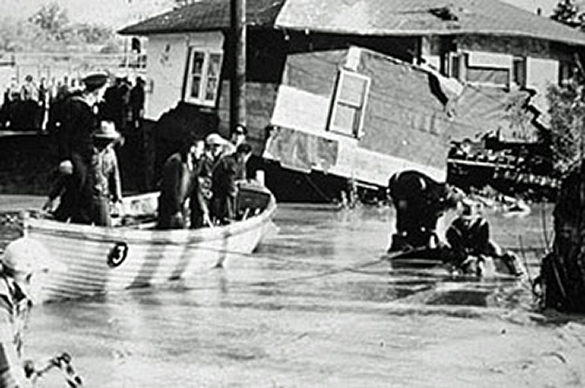
Lessons were learned from Hurricane Hazel. Conservation authorities, local municipalities, and the province together developed a plan for flood control and water conservation to reduce future risks and regulate vulnerable lands for recreation and conservation. The plans resulted in the development of dams, reservoirs, and major flood-control channels.
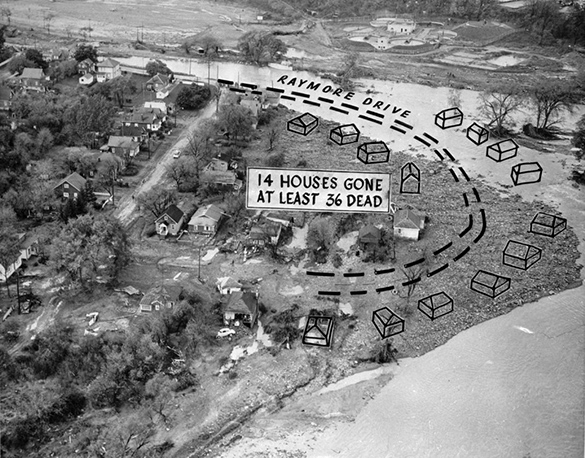
Source: Marsh, J. H. (2012, April 20). Hurricane Hazel. The Canadian Encyclopedia. https://www.thecanadianencyclopedia.ca/en/article/hurricane-hazel.
Considering the previous information you learned about Hurricane Hazel, assess the social, political, economic, and environmental impacts of the hurricane.
Complete the following Hurricane Impact graphic organizer in your notebook or using the following fillable and printable document. You can also use another method of your choice.
| Social | |
| Political | |
| Economic | |
| Environmental |
Press the ‘Activity’ button to access Hurricane Impact.
Check your answers with the following Hurricane Impact Answer Key.
Consolidation
Land uses and their impacts

Based on what you’ve learned about land-use, land reclamation, and the four kinds of impacts, respond to the following questions. Reference important ideas and concepts to help support your answers.
- What type of land use should be given priority: agriculture, recreation, conservation, or residential? Explain why you feel this way.
- What criteria should be considered when trying to make a decision about how a space might be used?
- Define social, political, economic, and environmental impacts in your own words.
Record your ideas in a notebook or another method of your choice.
Reflection
As you read the following descriptions, select the one that best describes your current understanding of the learning in this activity. Press the corresponding button once you have made your choice.
I feel...
Now, expand on your ideas by recording your thoughts using a voice recorder, speech-to-text, or writing tool.
When you review your notes on this learning activity later, reflect on whether you would select a different description based on your further review of the material in this learning activity.
Press ‘Discover More’ to extend your skills.
Discover MoreNow that you have a better understanding of how to assess the social, political, economic, and environmental impacts of a situation, you could investigate one of the following land-use conflicts or land reclamation projects. Your task is to develop a presentation in a method of your choice (for example, a slideshow, a poster, a website, a infographic, etc.) that will educate your audience on the impacts of one of these conflicts or projects. Use the checklist provided to ensure you haven’t missed anything.
